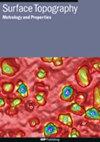材料配比参数数学软测量仪
IF 2
3区 材料科学
Q2 ENGINEERING, MECHANICAL
引用次数: 0
摘要
表面纹理分析软件的编辑需要验证其参数计算,最好是以独立于实施的方式进行验证。目前,还没有通用的参考方法来验证参数是否符合要求,特别是基于阿伯特曲线的材料比参数、Rk 参数和体积参数。几年前,在 Digital Surf,我们开发了基于数学的参数验证方法。通过数学参数定义注入一个由方程式定义的数学软测量仪,以获得参数值的数学真值。在平行路径中,通过算法注入从数学软测量导出的离散软测量,并将得到的值与近似真值进行比较。通过这种方法,可以检查算法计算特定参数的准确性。本研究专门设计了两个数学软测量仪系列来测试材料配比参数。更确切地说,本研究的两个主要目标是:(1) 提倡一种独立于任何软件实施的算法验证方法;(2) 根据阿博特曲线获得所有参数的真实值。本文章由计算机程序翻译,如有差异,请以英文原文为准。
Mathematical softgauges for material ratio parameters
Editors of surface texture analysis software need to validate their parameter calculations, ideally in an implementation-independent way. Today, there is no universal reference method for validating parameter compliance and more specifically with regard to material ratio parameters, Rk parameters, and volume parameters that are based on the Abbott curve. Several years ago, at Digital Surf, we developed parameter validation methods that are based on mathematics. A mathematical softgauge, defined by an equation, is injected through the mathematical parameter definition, to obtain a mathematical true value of the parameter value. In a parallel path, a discrete softgauge, derived from the mathematical softgauge, is injected through an algorithm and the resulting value is compared to the approximated true value. This method makes it possible to check the accuracy of an algorithm for calculating a particular parameter. For this study, two families of mathematical softgauges were specifically designed to test material ratio parameters. More precisely, the two main goals of this study are, (1) to advocate an algorithm validation approach that is independent from any software implementation, and (2) to obtain true values for all parameters based on the Abbott curve.
求助全文
通过发布文献求助,成功后即可免费获取论文全文。
去求助
来源期刊

Surface Topography: Metrology and Properties
Materials Science-Materials Chemistry
CiteScore
4.10
自引率
22.20%
发文量
183
期刊介绍:
An international forum for academics, industrialists and engineers to publish the latest research in surface topography measurement and characterisation, instrumentation development and the properties of surfaces.
 求助内容:
求助内容: 应助结果提醒方式:
应助结果提醒方式:


